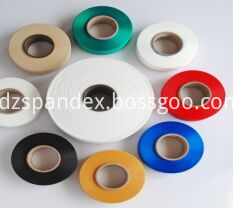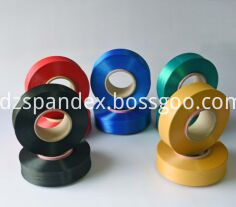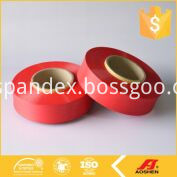Aoshen® Colorful Spandex fabric is elastane yarn which has pastel luster. Colorful spandex fabric that the color can keep long time, and will never fade.
Key technical of Exclusive color paste and painting process for spandex were developed by utilizing environmental-friendly and nontoxic paints and dispersants. Meanwhile, by improving the equipment and technical process, realized the industrial production of colorful spandex. Colorful spandex can help to simplify dyeing procedures, reduce production cost, does good to energy conservation and emission reduction, health and environmental-protection.
Advantage:
1. This series of product have pastel luster, pure color and colors can be customized.
2. The phenomenon of white exposed by spandex in dark fabrics can be eliminated thoroughly.
3. The color fastness reaches a high class and the color can keep long time, and never fade.
4. The rate of solvent residue is low and the pains used are environmental-friendly, nontoxic and healthful.
Application:
Widely applied to knitting, weaving and covering.
Colorful Spandex Colorful Spandex,Orange Color Polyester Spandex,White Color Spandex Fabric,Colorful Nylon Spandex LDZ New Aoshen Spandex Co.,Ltd. , http://www.ldzspandex.com The so-called “moon moonstone†is actually a “moonlight stone†in gemmology (the mineralogical name is “microclineâ€) because of the “moonlight effect†(the faint blue or bright white halo in the center of the gemstone appears) (Color) is called Moonstone.
The so-called “moon moonstone†is actually a “moonlight stone†in gemmology (the mineralogical name is “microclineâ€) because of the “moonlight effect†(the faint blue or bright white halo in the center of the gemstone appears) (Color) is called Moonstone.
It consists of a mixture of two feldspars. Among them, the combination of ice feldspar and albite is the most common. The moonstone with good quality is semi-transparent and has blue waves. Poorly semi-cloudy. The only ones that are lower are the iridescent and not blue. Moonstone belongs to biaxial crystal.
Moonstone refractive index 1.518 ~ 1.526, the relative density of less than 2.62 in the convex arc girdle ring belt often appear some small cleavage. Based on this, it can be distinguished from similar chalcedony, opal, glass or plastic. Moonstone emits pink fluorescence when exposed to short-wave ultraviolet light, and there is no or very weak fluorescence under long-wave ultraviolet radiation. Blue or violet-blue fluorescence under X-rays.
It should be pointed out that there are many gemstones with moonlight effects in nature, but only when the feldspar minerals have this effect they can be called moonstones. Other gemstones cannot use moonstone names even if they have a moonlight effect.
Native moonstones are produced in special dykes and pegmatites, but they are valuable from the placer and weathered layers. Important origins: Sri Lanka, India, Myanmar, Brazil, Madagascar, United States, Australia. There is also production in Inner Mongolia, China. In addition, some people think that ancient China's Hexagram is a moonstone.
Moonstone is a type of feldspar and is a sodium and potassium aluminosilicate. It is a mineral with two kinds of layers interacting with each other. The two layers of layers interact with each other and the visible light can be scattered, and the cleavages face the light to generate interference or diffraction. The integrated result can produce the moonlight effect, so it is called Moonstone, and the grade is high. Moonstone has drift-like blue light, and a few moonstones have a cat-eye effect.
Moonstone is beautifully silver and light blue and is used as a gem. Distant gabbros and labradorites in the plagioclase series of the feldspars are also called moonstones [2] because they all show beautiful iridescence. Moonstone's English name is MOONSTONE, literally translated as Moonstone. Because it is often milky white, translucent with a pale blue iridescent, like the moonlight after the rain in March, named Moonstone. For centuries, the luster of Moonstone, also known as glacier, is caused by the interference of diffuse reflections of some of the fine albite crystals in orthoclase. Moonstone is one of the people's favorite gems. People believe that it can awaken the gentle enthusiasm of the sweetheart. Together with pearls and changing stones, it is the lucky stone of the birth of June, symbolizing wealth and longevity.
Visual identification method
The essence of the visual identification method is based on the unique color, transparency, gloss, hardness, specific gravity, inclusion, dispersion, cleavage, fracture, birefringence, special optical effects and other characteristics of precious stones, with simple tools such as 10 times more magnifying glass, Concentrated flashlights, etc. for identification.
The theoretical basis for the visual identification method is that different gemstones have different features in appearance, physical properties and other aspects. Most gems can be classified into a broad range according to certain characteristics. Experienced persons can narrow this range to two or even three. For example, in the current market, some people think of Malay jade, green chalcedony, etc. as high-grade jadeite; red spinel as ruby; artificial products as natural products... In fact, as long as they have mastered the special gemstones, they do not need or use less identification equipment. Accurate identification can be done. The method for visually identifying a gem is now described as follows:
1. Look color
The first thing to notice is to observe the color of the gem. Regardless of the gem, the extent of the identification is somewhat reduced with the color and tone of the gem. Peridot special olive green color, so that we see it. A few of the precious stones are bright green, such as emeralds, decanters and some dyed gemstones. The black gemstones are only ebony, coal crystal, tourmaline, diopside, and black rock. Purple gems are amethyst, purple sapphire, spinel, cubic zirconia. In the identification of Jade, Malaysia jade and green chalcedony, if observed carefully, it can be found that the green distribution of jadeite is not uniform, the fracture is a dull, irregular fracture, the Malaysian jade color is distributed into a filament, the fracture is glassy , And there is a sense of sand, green chalcedony has a creamy and uniform distribution. The color of the dyed jadeite is not natural, and it is concentrated at the crevices. The natural color of jadeite is natural and the distribution is natural. Ruby is distinguished from the naked eye of the spinel by the presence of pleochroism in the ruby, placed in water, and sometimes visible in hexagonal bands, while the red spinel is absolutely uniform in color.
2. Look at transparency
Transparency can be used to understand the pros and cons of gems. In general, the same kind of gemstone, the more precious Zhao Gao is. Transparency can also be used to distinguish gems of similar colors but different types. The spinel is similar to the purple tooth, but the spinel is transparent and some of the purple teeth are opaque or translucent. The same is true for topaz and sapphire. Topaz is a transparent crystal, while sapphire is a clear, translucent to opaque distinction. Peridot is a transparent crystal, but jasper with similar color is opaque.
3. Look shiny
The gloss of a gemstone is an important visual inspection basis and can roughly determine a satisfactory range of refraction. Gloss is determined by the level of refractive index and the smoothness of the polished surface. The stronger the gloss of the unknown gemstone is, the higher the refractive index is. The refractive index of the semi-diamond glossy gemstone falls on the high refractive index range of the refractometer scale, and the glistening gemstone has its refractive index in the niobium range, while half of the work is off duty. Glossy gemstones have a lower refractive index. Waxy, luster-lustrous jade polished surfaces are relatively poor, and silky luster indicates that there are many acicular inclusions in the gemstones. The resin luster may be amber, and the arc-shaped surface has a play color, a translucent, cloud-like appearance, and the sky-blue milky luster is an ice-moon moonstone. The pearl luster is a long moonstone with a yellow-brown tone that is a long moonstone. Shining in the sunlight, the bright golden light is Sunlight Stone. Diamonds have a typical diamond sheen.
4. Test hardness
Some similar-looking gemstones can be distinguished by testing their hardness. For example, diamonds, zircons, crystals, etc. have similar hardness but different hardness. Diamonds can injure zircons and crystals, while crystals cannot scratch zircons. Again, ruby, red spinel, red tourmaline, purple ivory, etc. are all red-colored gems. Knowing the difference in their hardness, they can be distinguished by sculpting and distinguishing them.
The hardness of the main stones is as follows: Diamond - 10, Red Sapphire - 9, Gold Green Cat's Eye - 8.5, Spinel - 8, Topaz - 8, Zircon - 7.5-8, Emerald - 7.5 , tourmaline - 7-7.5; crystal - 7, purple Ukrainian Ukraine - 6.5-7.5, olivine - 6.5-7, opal - 5.5.
The use of hardness to distinguish gems need to pay attention to the following points:
This method has two limitations. The first is that some similar-colored gems are similar in hardness, such as zircon and purple teeth; second, they are powerless for synthetic gems, because artificial gems are very similar in physical properties to natural gems.
Don't use too much force when testing, especially if you can't knock, but slowly dragging.
Do not test light in one direction, but test in different orientations because the hardness of an individual gem differs in different directions. Such as kyanite hardness in the crystal elongation is 4.5 degrees, with a knife can be engraved, and its hardness in the direction perpendicular to it is as high as 6 degrees.
Gemstones, especially precious stones, cannot be scratched. The safer and more reliable method is to test with a polished mineral polisher. For example, to distinguish between the authenticity of the precious stones, it can be used to sculpt artificial spinel polishing sheet (hardness of 8), if it can mark the artificial spinel, then its hardness must be above 8 degrees, It may be ruby.
5. Weight ratio
The use of hand rubbed gemstones to estimate their proportions is a secret trick for experienced appraisers. It takes more practice to master them. For example, diamonds and colorless man-made cubic zirconia have a diamond-like proportion of 3.52, a cubic zirconia ratio of 5.8, and a ring of the same size. Or the diameter of an eye-turning gemstone can be roughly estimated by hand rubbing it.
When the conditions permit, the proportion can be measured by using a balance scale that is used in the jewelry store on a daily basis. At one end, a small blue wire made of fine gold or copper wire is hung. The gemstone is first put into the basket and weighed in the air, which is the weight of the gemstone in the air. Then the small blue with gemstone jewelry is immersed in a glass filled with water and the weight of the scale is reduced. This is the weight of the gemstone in the water. At this time, according to the principle of physics, the weight of the object lost in the water is equal to the object. The weight of the same volume of water discharged (but the water used is based on distilled water at 15°C or 60F). The result is as follows:
Specific gravity = weight in air / weight in air - weight in water
Then according to the proportion of gemstones, the corresponding gemstone name is found in the proportion table. The number of corresponding gems is many, but it can also be combined with hardness, color and other comprehensive analysis to determine the name of the gem.
There is also a more reliable method is the heavy liquid method, that is, with the proportion of the specific gravity of the gemstone to be measured, and then put the gemstone into the liquid to see if it is floating. For instance, the proportion of jadeite is 3.33, and it is placed in a heavy liquid of 3.2 grams per cubic centimeter. Jade is naturally sinking due to the fact that its specific gravity is greater than that of heavy liquid. If it rises, it will be an emerald. Of course, the preparation of heavy liquid requires a certain amount of raw materials, and the operation is not easy.
6. Observe the inclusion
Observing the characteristics of inclusions in transparent gemstones with a 10x magnifier is the most reliable method of distinguishing between natural and man-made objects. The inclusions of natural gemstones can be solids, liquids, gases, solids have many crystal forms; most of the artificial gemstones have bubbles, and the inclusions of the globular streaks are inclusions of synthetic gemstones.
7. Dispersion
In transparent flip gems, the intensity of dispersion can provide important clues for identification. Only diamonds, man-made cubic zirconia, zircon, rutile, demantoid, cassiterite, etc. can be seen to have a clear dispersion with the naked eye.
8. See fractures and cleavages
What kind of luster on the surface of fractures and fractures is particularly important for the identification of certain gemstones. Most gemstones with glass luster are conchoidal fractures, and translucent and opaque jade are mostly granular and jagged fractures. Such as coral fracture is dull, uneven fracture; amber fracture is resin luster, conchoidal fracture; chalcedony, agate fracture is resin luster, conchoidal fracture; turquoise is dull grease luster, granular or conchoidal fracture; Miyu and Dongling Stones are granular and irregular fractures.
Cleavage is also one of the basis for gem identification. Only a few gemstones have obvious cleavages, such as diamonds and topaz.
9. Birefringence and polychromism
A 10x magnifier can be used to see the double shadows at the edges of some of the translucent transparent gemstones. This feature is also an important basis for identifying gemstones. The common gemstones with strong double shadows are only zircon, olivine, tourmaline, and rutile.
The dichroism of some colored stones can be seen with the naked eye. Tourmaline blue-green and brown-green dichroism and rubies, sapphires, zircons, andalusite, alexandrite and so on as long as the rotation of the gem can see the obvious dichroism.
10. Look at special optical effects
Some gemstones have special optical effects. The appearance of any kind of optical phenomenon may reduce the prediction range of unknown gemstones. The top of the flip-shaped stones, placed on a white background, with a pen-type tube from the bottom of the sample irradiation from different angles, if you see the flat bottom surface or red circle around the waist, it may be purple teeth or glass Two-story stone, note red, purple or very thin samples do not see the red circle. A red flash of light from deep-colored bright blue gemstones can be thought of as artificial spinel or Tanzanian stone. Individual stones can produce color changes under different light sources. The altered stone is purple blue in natural light and reddish purple under tungsten light. Glazed iridescence changes color under different light. Opal has a special multicolored color change. There is often a snowflake flash inside the aquamarine. Common shore gems are ruby, sapphire, Hibiscus, purple teeth Ukraine. The four-pointed starlight gemstones are spinel, pyroxene, and hornblende. If the gemstone is thin and obvious, the other is wide and fuzzy. Under the magnifying glass, many seemingly metallic inclusions are diopside starlight gemstones. The common cat's eye gemstones are gold emeralds, crystals, aquamarine, tourmaline, feldspar, etc., the tour color is like a tiger's eye, and the eagle eye is a wooden metamorphic stone.
[Edit this paragraph]
price
In fact, the moonstone is not very expensive. Even if it is really a good moonstone, it can only be regarded as a mid-range jewel (because of the huge output). The moonstones that are generally sold in the mall will sell very expensively. It is best to go to the new street. Buy jewelry at the mouth, small camp and other jewelry wholesale center (if you are in the field, go to the local jewelry wholesale center to buy).
To a 6mm*8mm ring surface, Beijing's wholesale price is 15 ~ 30 yuan / grain range, the retail price is a little higher, about 25 to 45 yuan per piece. If it is inlaid, prices range from 50 to 300 yuan (depending on the type of inlaid metal used).
The moonstone produced by China is not worse than foreign ones, so the price is very cheap.
other
One of the most loving of all gems, it can enhance the sixth inspiration. It is also called "stone of lover" and can make two happy and happy.
The surface of the moonstone is a bit like the misty glass, delicate, soft and translucent. Due to the reflection of light in the internal structure, the albite in the interlayer emits attractive shades, mysterious and romantic luster, and resembles moonlight. The Indians regard the Moonstone as a holy stone, and the ancient Greeks and Romans were more convinced that Moonstone was full of powerful power at the full moon. It is said that Moonstone will be made of white gold to make it the best energy.
It is said that it is effective in the prevention of cancer, it can also prevent edema and other diseases, and it can also act on the solar plexus that corresponds to the sun wheel. It can cause pain when the sun wheel is turned on, but it can make people see themselves more clearly. The balance of the system can improve fertility and have a soothing effect on the physiological pain, but it is usually just to wear it and it is not necessary to wear it during the actual period.
There are many other names - because they can strengthen their ability to anticipate the future. They are called "stones of prophecy and perspective." Because they can protect travelers, they are also called "stones for travelers" because they can attract beautiful moonlight-like romantic love. Also known as the "stone of a lover," it allows men and women to excavate their own yin and yang and balance.





![KX68NZ8]Q[1]YI`$TA3C2]X KX68NZ8]Q[1]YI`$TA3C2]X](http://i.bosscdn.com/product/44/bc/e4/82723a95d2bf9a699c506d1ff8.jpg@watermark=2&color=I0ZGRkZGRg%3D%3D&type=ZHJvaWRzYW5zZmFsbGJhY2s%3D&size=22&p=5&t=80&text=bGR6c3BhbmRleC5ib3NzZ29vLmNvbQ%3D%3D)
![D[Q(QQ(~)60R%1B)PX49]MX D[Q(QQ(~)60R%1B)PX49]MX](http://i.bosscdn.com/product/7d/22/60/1439adbf21761d39296ede9bf4.jpg@watermark=2&color=I0ZGRkZGRg%3D%3D&type=ZHJvaWRzYW5zZmFsbGJhY2s%3D&size=22&p=5&t=80&text=bGR6c3BhbmRleC5ib3NzZ29vLmNvbQ%3D%3D)
![M@GPTS5NUY(]D``$(WM7Q_X M@GPTS5NUY(]D``$(WM7Q_X](http://i.bosscdn.com/product/06/c7/97/bf9520c6edb4b907b913cd59f8.jpg@watermark=2&color=I0ZGRkZGRg%3D%3D&type=ZHJvaWRzYW5zZmFsbGJhY2s%3D&size=22&p=5&t=80&text=bGR6c3BhbmRleC5ib3NzZ29vLmNvbQ%3D%3D)